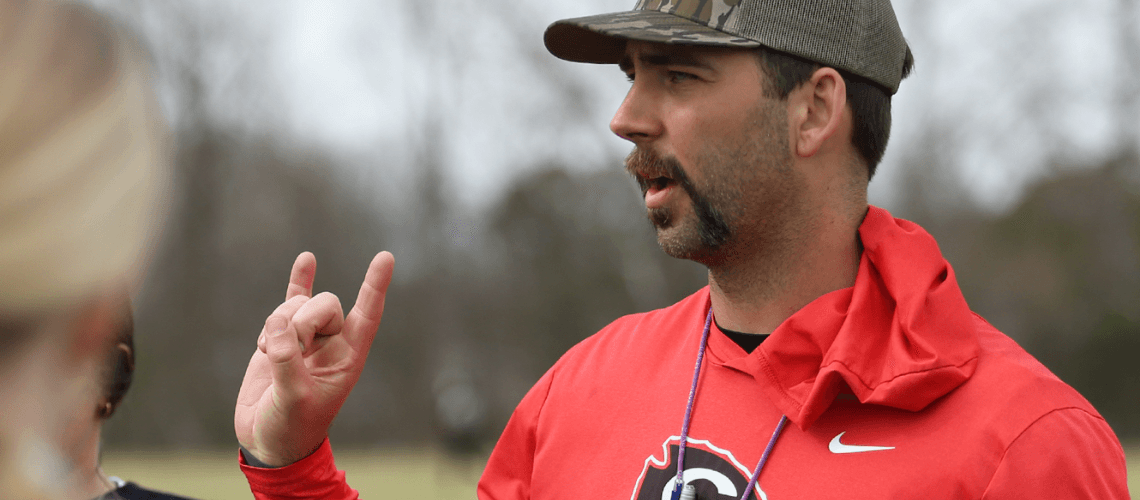By Andrew Rafferty
Rotation is a part of all sports and needs to be trained just like all other athletic qualities. However, it often gets overlooked. Almost all coaches are comfortable with programming in the weight room and in a speed setting, but might not be as comfortable with things like plyometrics or medicine ball throws. Throughout this article, I hope to bridge the gap and give coaches a practical way to utilize medicine ball throws to enhance rotational power in their athletes.
When looking at the technical side of rotational throws, it is important to understand the kinematic sequence that the body must go through in order to rotate efficiently. Rotation starts from the back foot and knee driving into the front leg, causing the hips to start to rotate. The hips will then lead to the torso, which will ultimately lead to the hands and then the implement (bat, ball, or club) rotating as well.
The biggest mistake made with rotational throws is that athletes will have their hands start the rotation, causing major power leaks. If a batter in baseball has his hands lead his swing, more than likely two things will happen. First, the hands will come away from the body, causing them to roll over the ball and hit an 87 hop ground ball to the pull side. And the player will not be able to get extension at the right time, causing him to slice off the baseball.
Outside of the kinematic sequence, the coach needs to make certain that the athlete achieves a “lead leg block.” This is where the front leg’s knee will extend while the back leg and hip drive forward.
As strength coaches, we have to make sure that we are not encouraging bad habits that will negatively impact the athlete’s ability to perform on the field. The number one problem I see with rotational throws is that coaches will chase outputs regardless of the technical flaws. It seems that coaches choose to quickly progress athletes to movements/drills that they might not be ready for. Whether it is done because of a lack of knowledge about progressing throws, or because the strength coach becomes enamored about a cool-looking drill, having an athlete perform a drill they aren’t ready for can lead to a negative outcome.
Progression Movements to Rotational Throws
I utilize three basic types of movements as progressions, when it comes to rotational throws: 1) ½ Kneel; 2) Bilateral Parallel; and 3) Athletic. Each one of these types of movements builds on the complexity of the previous one. The athlete’s technical ability will determine when you progress from one type of movement to the next. Ideally, I would like to progress every 3-6 weeks depending on the length of each mesocycle.
½ Kneel
The athlete will start with the back knee on the ground and the front knee up. I start with this set-up first because it allows the athlete to feel what it is like to drive their back hip through a firm front side. Athletes in this setup will tend to lean their upper half toward the wall as they go to throw. It is imperative that the athlete remains stacked throughout the throw.
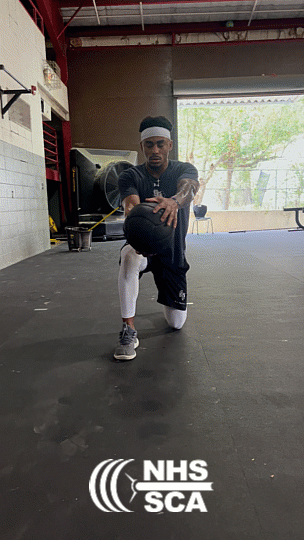
Bilateral Parallel
Once the athlete has shown the technical skill necessary in the ½ Kneel stance, they will transition into the Bilateral Parallel, or post-stride, stance. Their feet will be a little more than shoulder-width apart with the torso stacked on top of the pelvis. From this position, the athlete will counter-rotate away from the wall, then drive their back hip through the wall. In this position, athletes will be able to feel themselves transfer force from their back leg through their front leg.
When athletes first transition into this stance, a common flaw is having the hands lead the throw instead of the hip. If an athlete has this flaw, my first action is to slow them down during their counter-rotation. Once they get to the back of their counter- rotation, another athlete will briefly hold the ball and let the athlete begin to rotate towards the wall and then let go of the ball.
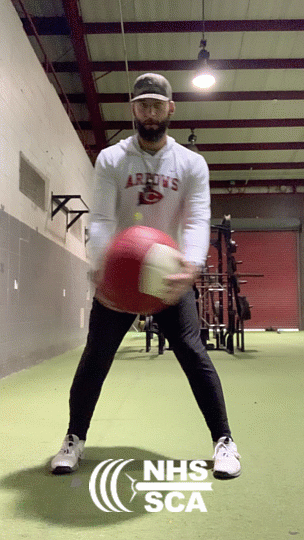
Athletic
In this stance, we begin to increase the rate-of-force development and the speed of the movement. If an athlete is in this stage, they have shown technical competence in 1/2 Kneel and Bilateral Parallel and are capable of efficient rotation. Do not be in a hurry to get athletes to this stage. They must have a good base or it will lead to negative results on the field of play. When athletes do start the Athletic progression, we increase the speed of the movement by giving athletes a chance to create movement prior to throwing. A few examples of this would be: shuffle scoop toss, step-back shot put, or a catch-and-release throw. The added speed of the movement increases the rate of force development, which is key for power development, but also increases the need for technical proficiency.
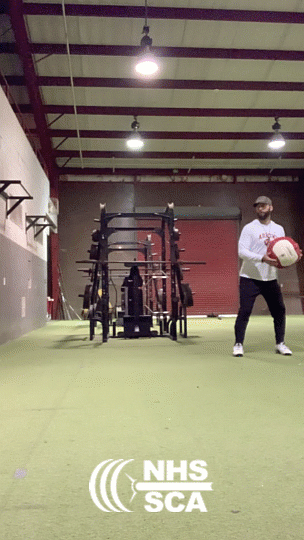

The biggest miscue with these movements is that athletes will be too hard on their front foot or “lunge” toward the wall. With non-rotational athletes, this isn’t as big of a deal as it is with our rotational athletes. Sports like baseball and softball require athletes to keep their weight back as their front foot hits the ground. If the athlete does lunge forward and the pitcher throws an offside speed pitch, the chance for success is minimal at best.
Using medicine ball throws is just like any other type of training, in the sense that as the coach you need to have a clear understanding as to why and how to implement. Keep things simple for the athletes and progress them as they show technical proficiency. Just because there is a cool drill done by a coach working with professional athletes doesn’t mean it’s right for high school athletes. No coach would have an athlete perform a heavy snatch on day one of training. First, they would learn how to perform the movement efficiently. The same should be done with medicine ball throws. Younger athletes need to learn how to rotate efficiently first, then complexity can be added.
Workout Example: Rotational Power Development (Progression)
½ Kneel Throws
| Exercise | Reps | Notes |
|---|---|---|
| ½ Kneel Scoop Toss (Right) | 3 sets x 8 reps | Focus on driving the back hip through a firm front side. |
| ½ Kneel Scoop Toss (Left) | 3 sets x 8 reps | Ensure torso remains stacked throughout the throw. |
Bilateral Parallel Throws
| Exercise | Reps | Notes |
|---|---|---|
| Bilateral Scoop Toss (Right) | 3 sets x 8 reps | Feet slightly wider than shoulder-width, torso stacked on the pelvis. |
| Bilateral Scoop Toss (Left) | 3 sets x 8 reps | Focus on transferring force from the back leg through the front leg. |
Athletic Stance Throws
| Exercise | Reps | Notes |
|---|---|---|
| Shuffle Scoop Toss (Right) | 3 sets x 8 reps | Increase speed of movement, keep weight balanced on front foot. |
| Shuffle Scoop Toss (Left) | 3 sets x 8 reps | Ensure the athlete does not lunge forward. |
| Step-Back Shot Put (Right) | 3 sets x 6 reps | Add movement before throwing to increase rate of force development. |
| Step-Back Shot Put (Left) | 3 sets x 6 reps | Maintain proper rotational mechanics. |
Progression Created Using HSSCC Principles. This Rotational Power Development (Progression) is meticulously developed utilizing the foundational principles taught in the High School Strength Coach Certified (HSSCC) program. The HSSCC is designed to equip strength coaches with the knowledge and skills to maximize athletic performance safely and effectively.
Progression:
- Weeks 1-3: Focus on ½ Kneel stance with the athlete mastering hip drive and rotational mechanics.
- Weeks 4-6: Progress to Bilateral Parallel stance, emphasizing the force transfer from back leg to front leg.
- Weeks 7-9: Transition into Athletic stance, increasing the speed and complexity of the throws, focusing on rate-of-force development.
Notes:
- As athletes progress, focus on gradually increasing the speed of the movements without sacrificing form or adding weight at the expense of proper technique.
- Ensure athletes maintain proper rotational technique before progressing to more complex movements.
Guiding Principles for Integration
Incorporating rotational medicine ball throws into a dynamic effort or power day alongside traditional exercises can be an excellent way to enhance explosive power and overall athleticism. Here’s how you can do this while maintaining the intent of the dynamic effort (speed-strength) training:
- Pairing with Traditional Exercises: Use rotational medicine ball throws in a superset with traditional barbell lifts (like squats, deadlifts, or presses) to develop rotational power and overall explosiveness.
- Volume and Intensity: Keep the medicine ball throws at moderate volume (around 3-5 sets of 3-8 reps), and maintain the focus on speed and technique.
- Training Blocks: Incorporate the throws early in the workout (after a warm-up) or as active recovery between dynamic barbell movements.
- Complementary Nature: Choose rotational movements that enhance the explosive nature of your dynamic effort lifts without causing fatigue before the main lifts.
Example Dynamic Effort/Power Day Structure
Power Day Superset:
- Superset Traditional Dynamic Lift with Rotational Throw:
- A1: Dynamic Box Squat (50-60% of 1RM) – 8 sets x 2 reps
- A2: Shuffle Scoop Toss (Right/Left) – 3 sets x 5 reps (each side)
- Rest: 90 seconds between each superset
- Superset Explosive Push Lift with Medicine Ball Throw:
- B1: Dynamic Bench Press (50-60% of 1RM) – 8 sets x 3 reps
- B2: Step-Back Shot Put (Right/Left) – 3 sets x 5 reps (each side)
- Rest: 90 seconds between each superset
- Superset Lower Body Power Movement with Bilateral Throws:
- C1: Power Clean (or Speed Deadlift) – 6 sets x 3 reps
- C2: Bilateral Scoop Toss (Right/Left) – 3 sets x 6 reps
- Rest: 90 seconds between each superset
Dynamic Effort Day Example Workout:
| Exercise | Sets | Reps | Notes |
|---|---|---|---|
| A1. Dynamic Box Squat | 8 | 2 | 50-60% of 1RM, focus on speed and explosiveness |
| A2. Shuffle Scoop Toss (Right) | 3 | 5 | Pair with squats, focus on quick hip rotation |
| A3. Shuffle Scoop Toss (Left) | 3 | 5 | |
| B1. Dynamic Bench Press | 8 | 3 | 50-60% of 1RM, emphasis on speed and bar velocity |
| B2. Step-Back Shot Put (Right) | 3 | 5 | Focus on strong rotational power, step into the throw |
| B3. Step-Back Shot Put (Left) | 3 | 5 | |
| C1. Power Clean | 6 | 3 | Develop explosive lower body power |
| C2. Bilateral Scoop Toss (Right) | 3 | 6 | Feet shoulder-width apart, focus on full body power transfer |
| C3. Bilateral Scoop Toss (Left) | 3 | 6 |
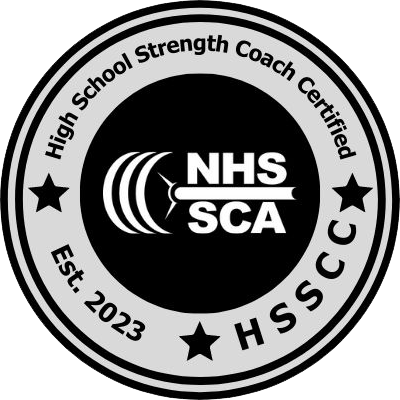
Integration Principles Created Using HSSCC Principles. This Dynamic Effort Day Example Workout is meticulously developed utilizing the foundational principles taught in the High School Strength Coach Certified (HSSCC) program. By earning the HSSCC certification, coaches gain access to cutting-edge methodologies like these, ensuring their athletes excel in power, speed, and strength development, all while promoting proper technique and reducing injury risk.
Explanation:
- Rotational Throws as Supersets: Rotational medicine ball throws are placed immediately after traditional dynamic exercises (like box squats or bench presses) to further develop speed and power.
- Volume Control: Medicine ball throws are typically low in volume (3-5 sets) to ensure the athlete maintains speed and proper form.
- Focus on Speed: Dynamic effort days prioritize bar velocity and explosive movement. Medicine ball throws fit perfectly because they also emphasize quick force production, enhancing the athlete’s ability to apply force rapidly.
- Variation: By combining bilateral, unilateral, and athletic stance throws, you add variety to rotational work and ensure athletes build power across different planes of movement.
By adding these medicine ball throws into dynamic effort or power days, you create a well-rounded approach that enhances both linear and rotational power, crucial for athletic development.
Andrew Rafferty is the Strength & Conditioning Coordinator for Clinton Public Schools in Clinton, MS, and has served in this position for nine years. He was named the 2023 NHSSCA Mississippi State Coach of the Year, and 2024 NHSSCA Southeast Regional Coach of the Year.


